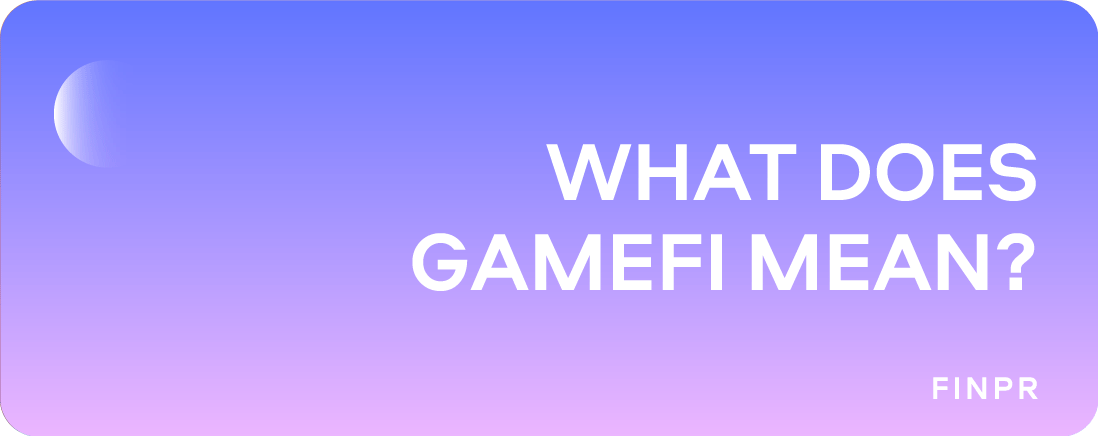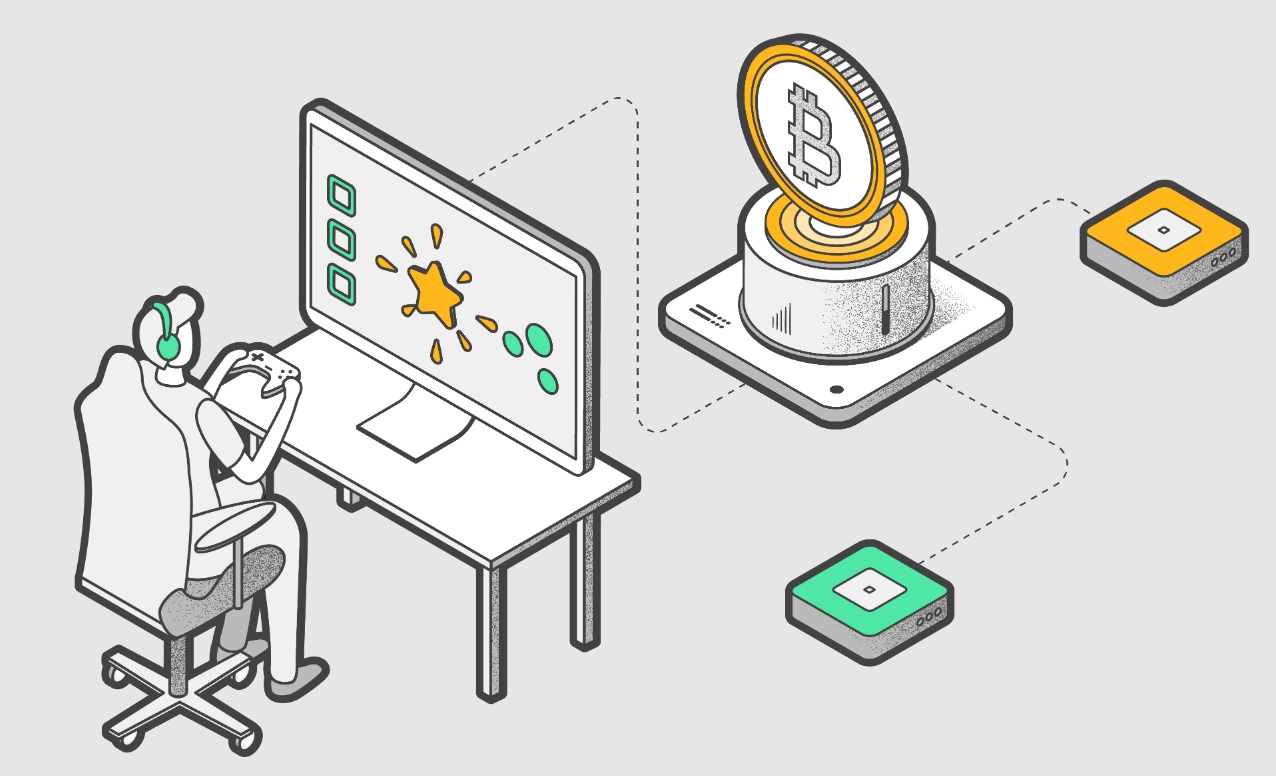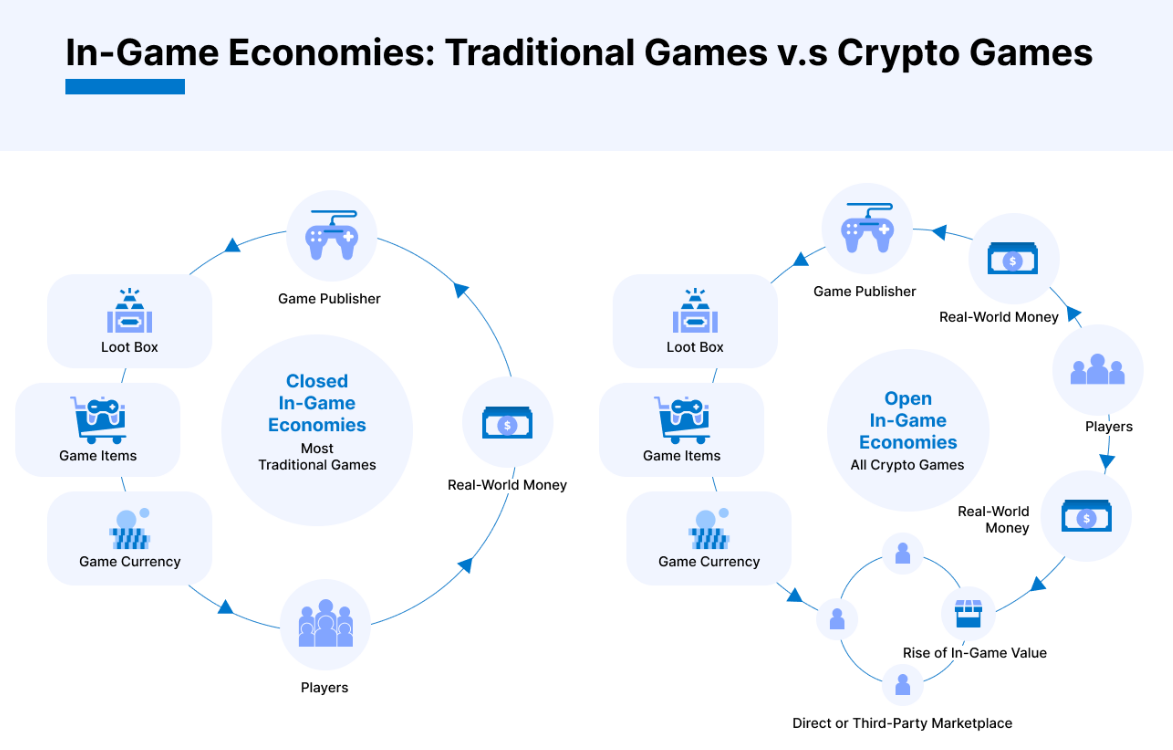
GameFi, a portmanteau of "gaming" and "finance," represents a revolutionary fusion of online gaming and decentralized finance (DeFi). This innovative concept leverages blockchain technology to create play-to-earn (P2E) models, where players can earn cryptocurrencies and non-fungible tokens (NFTs) through gameplay. Unlike traditional gaming, where in-game assets and rewards often have no real-world value, GameFi enables players to own, trade, and monetize their in-game achievements in the broader crypto ecosystem.
This article provides a comprehensive guide to GameFi, exploring its definition, core components such as blockchain technology, DeFi, NFTs, and play-to-earn models, and highlighting the transformative impact of these elements on the gaming industry.
Introduction to GameFi
Historical Context and Evolution
The concept of earning real-world value through gaming isn't entirely new. Early examples include in-game gold farming in massively multiplayer online role-playing games (MMORPGs) like World of Warcraft, where players would sell in-game currency for real money. However, these practices were often against the game's terms of service and carried risks for players.
The advent of blockchain technology and NFTs has formalized and expanded these opportunities, making GameFi a legitimate and secure way to earn through gaming. The launch of pioneering games like CryptoKitties in 2017 showcased the potential of blockchain gaming by allowing players to buy, breed, and sell unique digital cats as NFTs. This paved the way for more sophisticated GameFi projects that integrate complex economic models and DeFi mechanisms.
Impact and Popularity
GameFi has rapidly gained popularity due to its potential to democratize gaming and provide new income opportunities. In regions with limited economic opportunities, GameFi has become a viable source of income for many. Games like Axie Infinity have demonstrated this potential by allowing players in countries like the Philippines to earn a living wage through gameplay.
Moreover, GameFi attracts not only gamers but also investors and crypto enthusiasts looking to capitalize on the burgeoning intersection of gaming and blockchain technology. The sector has seen significant investment from venture capital firms, indicating a strong belief in its growth potential.
Core Components of GameFi

Blockchain Technology
Role of Blockchain in GameFi
Blockchain technology is the foundational element of GameFi, ensuring transparency, security, and true ownership of in-game assets. Unlike traditional gaming, where assets are stored on centralized servers controlled by game developers, blockchain-based games use decentralized ledgers. This decentralization ensures that players have permanent ownership and control over their digital assets, which can be independently verified and are immune to manipulation or loss by the game developers.
Smart Contracts
Smart contracts, which are self-executing contracts with the terms of the agreement directly written into code, play a crucial role in automating game mechanics and transactions. They facilitate decentralized governance, automated reward distribution, and ensure that game rules are transparent and immutable. This automation reduces the need for intermediaries and enhances the trustworthiness of GameFi platforms.
Decentralized Finance (DeFi)
Integration of DeFi Elements
DeFi elements such as staking, liquidity mining, and yield farming are integral to the GameFi ecosystem. These mechanisms allow players to earn passive income by utilizing their in-game assets. For instance, players can stake their game tokens to earn additional rewards or provide liquidity to decentralized exchanges, enhancing the game's economy and earning returns on their investments.
Staking and Yield Farming
Staking involves locking up a certain amount of cryptocurrency to support network operations and in return, earning rewards. In GameFi, players can stake their in-game tokens to earn exclusive items, access new game levels, or receive additional tokens. Yield farming, on the other hand, involves providing liquidity to DeFi platforms in exchange for interest or additional tokens, thereby increasing the utility and value of in-game assets.
Non-Fungible Tokens (NFTs)
Representation of In-Game Assets
NFTs are unique digital tokens that represent ownership of in-game assets such as characters, equipment, land, and more. Each NFT is distinct and can be bought, sold, or traded on blockchain marketplaces. The use of NFTs ensures that in-game assets have real-world value and can be freely traded outside the game environment, providing players with greater financial flexibility and opportunities.
Minting and Trading NFTs
Minting is the process of creating NFTs on the blockchain. In GameFi, players can mint new NFTs by creating or acquiring rare in-game items. These NFTs can then be traded on various marketplaces, enabling players to monetize their gaming achievements. This trading ecosystem adds a new layer of economic activity to gaming, allowing players to profit from their skills and investments in the game.
Play-to-Earn (P2E) Models
Earning Mechanisms
The core principle of GameFi is the play-to-earn model, where players earn rewards for their in-game activities. These rewards can be in the form of the game's native cryptocurrency, NFTs, or other digital assets. Players can earn these rewards by completing quests, winning battles, or achieving specific milestones within the game.
Economic Incentives
P2E models provide significant economic incentives, transforming gaming from a leisure activity into a potentially lucrative endeavor. This model democratizes earning opportunities, allowing players from different economic backgrounds to participate and benefit financially from their gaming efforts. The economic incentives in GameFi not only enhance player engagement but also attract a broader audience to the gaming ecosystem.
GameFi marketing strategies play a crucial role in attracting and retaining players by promoting the unique financial incentives and ownership opportunities offered by blockchain-based gaming platforms.
Comparing GameFi and Traditional Gaming

Economic Models
Pay-to-Play vs. Play-to-Earn
Traditional gaming primarily follows a pay-to-play model where players either purchase the game upfront or pay a subscription fee to access its content. For instance, popular titles like "World of Warcraft" and "Call of Duty" require players to buy the game or pay for monthly access.
In contrast, GameFi adopts a play-to-earn (P2E) model, where players earn rewards through gameplay. These rewards are often in the form of cryptocurrencies or NFTs, which can be traded or sold for real-world value.
In-Game Currencies and Assets
In traditional games, in-game currencies and assets are confined to the game’s ecosystem and hold no real-world value. Players can earn or purchase these items but cannot monetize them outside the game.
Conversely, GameFi utilizes blockchain technology to tokenize in-game assets, making them tradable on external marketplaces. This provides players with the opportunity to earn real money through their gaming activities.
Ownership and Control
Centralization vs. Decentralization
Traditional games are typically centralized, meaning the game developers have full control over the game’s servers, assets, and player accounts. This centralization allows developers to modify game rules, reset progress, or even ban players at their discretion. A notable example is the ability of game companies to revoke access to games due to terms of service violations.
On the other hand, GameFi operates on decentralized networks, giving players true ownership of their in-game assets. These assets are stored on the blockchain, ensuring that players retain control and can trade or sell them independently of the game developers.
Asset Permanence and Security
In centralized games, the permanence of in-game assets is subject to the developer’s policies and the game’s lifespan. If a game shuts down, players can lose all their progress and assets.
GameFi addresses this issue by ensuring that in-game assets, represented as NFTs, remain on the blockchain permanently, regardless of the game’s operational status. This decentralization also enhances security, as players’ assets are not tied to a single point of failure.
Monetization Models
Revenue Streams
Traditional gaming companies primarily monetize through game sales, subscriptions, and in-game purchases. These models focus on generating revenue from the players, often through microtransactions for cosmetic items, expansions, or other in-game advantages.
GameFi introduces additional revenue streams by allowing players to earn through gameplay. Players can monetize their skills and time by earning and trading NFTs and cryptocurrencies. This model not only benefits players but also aligns the interests of developers and gamers towards a shared economic ecosystem.
Player Incentives
In traditional gaming, player incentives are mostly intrinsic, such as enjoyment, achievement, and social interaction. While some games offer extrinsic rewards, these are generally confined within the game.
GameFi enhances player incentives by adding tangible financial rewards, providing a stronger motivation for players to engage deeply with the game. This financial aspect can attract a broader audience, including those who might see gaming as a potential source of income.
Community and Governance
Traditional games are developer-driven, with game companies making decisions about game updates, content, and policies. Player feedback is considered, but the final decisions rest with the developers.
In contrast, many GameFi projects use decentralized autonomous organizations (DAOs) to involve the community in decision-making. Players who hold governance tokens can vote on proposals and influence the future development of the game. This community-driven approach fosters a more democratic and engaged player base.
Summarizing Key Points
GameFi merges gaming and decentralized finance to create a novel play-to-earn model, empowering players with true ownership of digital assets and the ability to monetize their in-game activities. By leveraging blockchain technology, NFTs, and DeFi mechanisms, GameFi provides a transparent, secure, and financially rewarding gaming experience. This paradigm shift contrasts with traditional gaming’s centralized control and pay-to-play models, offering new economic opportunities and community-driven governance.
As GameFi continues to evolve, it promises to reshape the gaming industry and open up new avenues for digital entertainment and finance.




